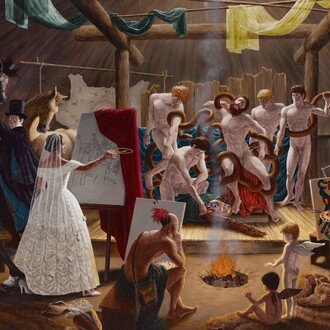A captivating exhibition on the fascinating, multifaceted figure of the witch! Pointe-à-Callière, Montréal’s archaeology and history complex, presents the exhibition Witches. Out of the shadows, an immersion into the little-known history of witches, lifting the veil on their fascinating and mysterious world. From marginalized figures to symbols of modern feminism, learn how these women inspired popular culture and asserted their influence down through the centuries. A unique experience in which myths and reality intersect and intertwine, revealing the timeless essence of witches.
Evil, helpful, victim or rebel… the witch is an iconic figure whose various representations have evolved over the centuries and in our collective imagination. Against a captivating backdrop, this exhibition takes visitors on a moving journey through 400 objects from the private and institutional collections of over 30 European and North American museums. Authentic witnesses of the rich history of witches and their world.
We are delighted to invite the public to explore the fascinating world of witches! Remaining true to the approach of Pointe-à-Callière, Montréal’s archaeology and history complex, Witches. Out of the shadows offers a historical perspective of the subject matter through authentic objects, while engaging visitors’ senses and imaginations. In a broader perspective, we hope that this exhibition will convey the importance of approaching history with an open and inclusive mind, recognizing that historical events and beliefs are shaped by the cultural and social contexts of their time. It is a unique way to understand the lasting influence witches have had on culture and our contemporary values.
(Anne Élisabeth Thibault, Executive Director, Pointe-à-Callière)
Witch hunting. A historical reality
In exploring the dark era of witch hunts in the 16th and 17th centuries, when tens of thousands of women were persecuted and executed, the exhibition takes a sensitive and tangible approach to the construction of the myth of the diabolical witch: this woman responsible for illness, death, and all other manner of ills in a society in crisis. This historical immersion into Europe and North America allows us to pull back the veil on the practices and trials that saw close to 100,000 women meet tragic fates, from banishment to the stake. Among the pieces on display is a copy of the Malleus Maleficarum (The hammer of witches), the misogynistic and sadly well-known treatise that played a key role in legitimizing and intensifying the practice of witch hunting.
Ancestral know-how and esoteric practices
The world of witchcraft is an open window onto a broad spectrum of fascinating know-how and practices. From knowledge of medicinal plants to the art of divination, visitors are invited to explore the rituals of sorcery through a vast array of symbolic objects. Pendulums, crystals, tarot cards, and herbariums—these artifacts reveal the powers attributed to the practices of sorcery, such as healing, enchantment, protection, and predicting the future.
An iconic cultural figure
As a central figure in literature and popular culture, the witch is represented in an inexhaustible number of ways. From the old hag in folk tales to the independent and rebellious young witches in modern-day films and series, the exhibition explores the witch’s burgeoning evolution through pop culture, reflecting the evolving roles and perceptions of women over time. A fun and enlightening section, illustrating witches’ emblematic attributes, features audiovisual archives and sumptuous costumes.
Witches today
Today, the witch is a symbol of resilience and liberty, notably highlighted by contemporary feminist movements. Through the art and accounts of modern-day witches, the exhibition celebrates their heritage, which remains very much alive. In the spirit of sharing the perspectives of witches past and present, a series of lectures will be held to coincide with the exhibition. Among the lecturers the Museum will host are Vanessa DL, Catherine Éthier, Catherine Ferland, and others.
In rehabilitating our memory of witches, this exhibition invites the public to profoundly reflect on the diversity, emancipation, and resilience of women down through the ages.
















